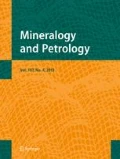Summary
The structure type of joaquinite has been derived from precession photographs (Mo radiation) of a polysynthetic twin. Space group: C 2/m; lattice constants:a=10.50Å,b=9.58Å;c=11.78Å;β=109°32′;cell content: Ba4Fe2RE4Ti4O4[Si4O12]4.
The atomic arrangement was determined by Patterson-, Fourier-, and (F0−Fc)-syntheses. The least squares refinement (with isotropic temperature factors) led toR=0.16. The authors are of the opinion that this relativeley highR-value is due to the poor quality of the crystal.
The main structural feature are double layers of [Si4O12]-rings parallel to (001) which are connected by 10-coordinated Ba and octahedrally coordinated Ti. These double layers have pseudo-symmetry C mmm, with mirror planes perpendicular toa, b, andc *. They are stacked alongc * and translated −3/8a. The orthorhombic pseudo-symmetry allows also the translation +3/8a which is responsible for both the formation of twins and the frequent stacking disorder. The described double layers are connected by 7-coordinated RE and 4-coordinated Fe.
The rôles of Fe, which has an occupancy of only 1/2, and of Na and OH. which are reported in published analyses, are discussed.
Zusammenfassung
Der Strukturtyp von Joaquinit wurde aus Präzessionsaufnahmen (MoStrlg.) eines polysynthetischen Zwillings abgeleitet. Raumgruppe: C 2/m; Gitterkonstanten:a=10,50Å;b=9,58Å,c=11,78Å; β=109°32′, Zellinhalt: Ba4Fe2SE4Ti4O4[Si4O12]4.
Die Atomanordnung wurde aus Patterson-, Fourier- und (F0−Fc)-Synthesen abgeleitet. Die Verfeinerung mit der Methode der Kleinsten Quadrate führte (mit isotropen Temperaturfaktoren) aufR=0,16. Die Autoren sind der Ansicht, daß dieser relativ hoheR-Wert von der schlechten Qualität des Kristalles herrührt.
Wesentliches Strukturmotiv sind Doppelschichten von [Si4O12]-Ringen parallel (001), die durch 10-koordiniertes Ba und oktaedrisch koordiniertes Ti verknüpft werden. Diese Doppelschichten haben die Pseudosymmetrie C mmm mit Symmetrieebenen senkrechta, b undc *. Sie werden nachc * gestapelt und um −3/8a translatiert. Die rhombische Pseudosymmetrie läßt andererseits die Translation +3a zu, was für die Zwilligsbildung und die häufige Stapelungsunordnung verantwortlich ist. Diese Doppelschichten werden weiter durch 7-koordinierte SE und 4-koordinertes Fe verknüpft.
Die Rollen des Fe, welches eine Punktlage nur zur Hälfte besetzt, und des Na und OH, welche in publizierten Analysen angegeben werden, werden diskutiert.
Similar content being viewed by others
References
Bell, C. K., 1963: X-ray examination of a Canadian occurrence of joaquinite. Dept. of Mines and Tech. Surveys. Geol. Surv. Can. Rept.MS 63–87.
Christophe-Michel Lévy, M., 1961: Reproduction artificielle de quelques minéraux riches en zirconium (zircon, eudialyte, catapléite, elpidite); comparaison avec leur conditions naturelles de formation. Bull. Soc. franç. Min Crist.84, 265–269.
Deer, W. A., R. A. Howie andJ. Zussmann, 1962: Rock forming minerals, vol. 1, Ortho and Ring Silicates, p. 256, 258. London: Longmans.
Guiseppetti, G., F. Mazzi andJ. Tadini 1971: The crystal structure of eudialyte. Tschermaks Min. Petr. Mitt.16, 105–127.
Golyshev, V. M., V. I. Simonov andN. V. Belov 1971: On the crystal structure of eudialyte. Kristallgrafiya16 93–98. Soviet Physics Crystallography16, 70–74.
Louderback, G. D., 1909: Benitoite. Bull. Univ. of California, Dept. of Geology5, 376.
Pabst, A., 1943: The crystal structure of gillespite, BaFeSi4O10. Amer. Min.28, 372–390.
Palache, C., andW. F. Foshag 1932: The chemical nature of joaquinite. Amer. Min.17, 308–312.
Semenov, E. I., V. I. Bukin, Yu. A. Balashov, andH. Sørensen, 1967: Rare earths in minerals of the joaquinite group. Amer. Min.52, 1762–1769.
Author information
Authors and Affiliations
Additional information
Mit 10 Abbildungen
Rights and permissions
About this article
Cite this article
Cannillo, E., Mazzi, F. & Rossi, G. The structure type of Joaquinite. TMPM Tschermaks Petr. Mitt. 17, 233–246 (1972). https://doi.org/10.1007/BF01082804
Received:
Revised:
Issue Date:
DOI: https://doi.org/10.1007/BF01082804



